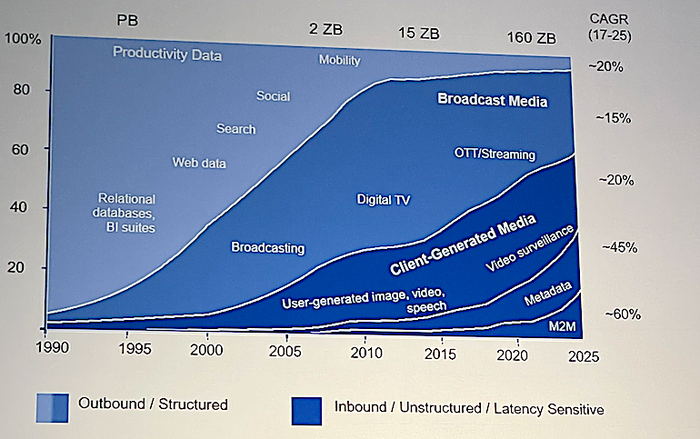Communication innovations must keep up with the evolving nature of data.
September 1, 2021

“Let’s talk about the shifting nature of data,” stated Mike Fitton at the opening DesignCon Keynote. “Three things are really necessary for us to drive wireless connection in the future.”
Before revealing these three key elements, Fitton talked about how the shifting nature of data motivated a new generation of technologies. Data had been relatively static from the 1990s. It was also very structured, which made it relatively easy to access.
Starting roughly around 2000, network data became more inbound, less structured, and very latency-sensitive. More user-generated images, video, and speech data emerged. Video surveillance, metadata, and machine-to-machine inbound data continued to grow. In addition to this explosion of different data types, a compounding effect or force multiplier was realized when computing at the edge.
Rather than doing all the processing in a central location, as was done 10 to 20 years ago, today’s data is getting pushed out to edge computations. This results in a force multiplier effect with advanced wireless networking that allows the addressing of newer applications at the edge. Such applications include AI machine learning, AI training, or reinforcement of a wide variety of different requirements that are all getting pushed out towards the edge. Of course, these applications increase the computational need.
But in addition to increasing the computational need, one must remember that edge devices typically operate in a thermally constrained environment – typical for small form factor embedded hardware. So there are colliding requirements that require continuous innovation to be able to address these challenges and more.

All of which leads up to the three critical elements needed for future wireless connectivity: programmability – to necessary for us to drive wireless connections in the future is going to be
Programmability – to provide flexibility in the future, especially with evolving standards.
Performance - to drive up the bandwidth and the capacities, and
Scalability – to provide the breadth to be able to address a wide variety of different requirements.
John Blyler is a Design News senior editor, covering the electronics and advanced manufacturing spaces. With a BS in Engineering Physics and an MS in Electrical Engineering, he has years of hardware-software-network systems experience as an editor and engineer within the advanced manufacturing, IoT and semiconductor industries. John has co-authored books related to system engineering and electronics for IEEE, Wiley, and Elsevier.
About the Author(s)
You May Also Like





